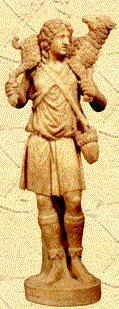
In Jesus’ Shepherd Discourse in John 10, Jesus contrasts himself with “the thief.” “The thief comes only to steal and kill and destroy; I came that they may have life and have it in abundance.” If you hear this verse quoted in a sermon, or see how people use this verse online, you will usually hear that the thief is Satan. But is that what Jesus meant?
All of John 10:1-18 hangs together as a single discourse, split up into three connected shepherd parables. So if we want to understand what Jesus meant by thief, we need to (surprise!) look at the context. Once we look at the whole discourse, it becomes clear that the thief does not refer to Satan, but to Jesus’ opponents, the self-serving human leaders of Israel.
First, the entire shepherd discourse is a direct response to the Pharisees’ mistreatment of one of Jesus’ sheep, the blind man (John 9). There is no natural break between John 9 and 10; in fact, that particular chapter break was probably improperly placed. Thomas Cajetan commented in the early 1500s that “the person who divided the text of the Gospel into chapters was not very judicious in beginning John 10 here.”[1] Jesus goes directly from condemning the Pharisees in John 9:39-40 to a set of parables that contrasted his own leadership with that of the Pharisees.
Second, each of the three parables is about a contrast between Jesus and the failed leaders. They are foolish gatekeepers who cannot tell the difference between a thief and a shepherd (John 10:1-6).[2] Then they are thieves who bring death, while Jesus is the sheepfold gate that brings life (John 10:7-10). Finally, they are the hired hands who abandon the sheep at the first sign of danger, while Jesus is the good shepherd who lays down his life for his sheep (John 10:11-18).
Third, within this particular parable – only one short paragraph! – Jesus is clear that “all who came before me are thieves and bandits… the thief comes only to kill and steal and destroy” (John 10:8-10). There is no hint that he has switched topics. Within a single parable, we expect the symbols to stay the same, so there is no reason to think that Jesus has started to talk about Satan. So the overall context, moving from John 9-10, down to the discourse, and then down to the parable in John 10:7-10, makes it clear that the thief is a reference to the failed leaders of Israel.
There is another approach we should take. In general, symbols in the New Testament were not new; instead, Jesus and the apostles used existing symbols from the Old Testament or from their culture. For example, shepherd had been a metaphor for king for at least a thousand years before Jesus used the metaphor here; this is why the crowds soon ask him if he is claiming to be the Messiah, the expected king (John 10:24).
This line of questioning also confirms that thief does not refer to Satan. Thief is not used as a metaphor for Satan in the Old Testament, the New Testament, or other ancient Jewish literature. However, thief and bandit are used as metaphors for the leaders of Israel in the Old Testament (Isa 1:23, Jer 2:26, 7:11, 23:30). At least 20 other ancient Jewish documents described the ruling Jewish priests as thieves.[3] In fact, Jesus was intentionally reusing an existing shepherd parable from Ezekiel 34. In Ezekiel 34, God condemns the failed leaders of Israel, who have stolen from the sheep, killed them and caused them to become scattered. God says that he will remove these hired shepherds and replace them with himself and David as shepherds. Jesus is doing the same thing in John 10. He condemns the leaders of Israel as thieves and points to himself as the only true shepherd.
So if it so clear that the thief refers to failed human leaders, why do so many sermons today refer to the thief as Satan? How did the interpretation thief = Satan develop?
The church fathers all agreed that the thief referred to the failed leaders of Israel (like the Pharisees), or failed revolutionary leaders (like Theudas). Augustine, Chrysostom, Clement of Alexandria, Theodore of Mopsuestia and others all had this interpretation. None of them ever suggested that Jesus was talking about Satan in John 10.
The commenters of the Reformation era up through the nineteenth century all agreed that the thief referred to failed human leaders and their false teaching. I was unable to find a single commentary from those centuries that even mentioned the interpretation that the thief referred to Satan. John Calvin, as he explained that the thief referred to false teachers, mentioned that Satan is the source of false teaching, but he still did not interpret the thief as Satan.
In the 1800s and early 1900s, many denominations produced Sunday School curriculum and Bible study-oriented newspapers. (The amount of obscure documents that can be accessed on Google Books is quite amazing!) When these curricula covered John 10, they nearly always gave the traditional interpretation: the thief represents failed human leaders in lsrael, and this can be applied to false teachers today.
But there was an interesting change that happened some time in the mid-1800s. A few devotional books and some Sunday School curriculum (but still a minority, and no commentaries) began to say that the thief referred to Satan. It appears that they picked this interpretation up from (it gets complicated here) Aquinas’ misinterpretation of an obscure 11th century commentary by Theophylact of Ohrid. Theophylact claimed that the thief represented revolutionary leaders of Israel, and the wolf (John 10:12) was Satan. Then he said that the wolf/Satan was like the thief in certain ways. In the process of abbreviating Theophylact’s view for his Catena Aurea, Aquinas made it sound like Theophylact taught that the thief was Satan. Finally, the view that the thief was Satan began to appear in a few mainstream commentaries in the early 1900s (Arthur Pink is a notable example). But by the mid-20th century, commentaries again began to return to the traditional view that the thief referred to false leaders.
So the traditional view, that Jesus was contrasting himself with failed leaders of Israel, can be seen clearly in the text of John 9-10, and was the standard view (with some minor variations) from the second century until the nineteenth century. For about one century (1850-1950), some people, including some scholars, thought that the thief was Satan. For the past sixty years, almost all commentaries and scholars of John have held the original standard view.
So why does thief = Satan prevail in pulpits? I suggest that one reason is that many pastors sometimes make interpretation decisions based on oral tradition rather than based on research. We often succumb to the temptation to repeat slogans and interpretations that we have heard, instead of studying and consulting careful biblical scholarship.
Endnotes
[1] T. Cajetan, In quattuor Evangelia, cited in John 1-12 (Reformation Commentary on Scripture: New Testament IV), ed. Craig Farmer, p. 368.
[2] The first parable is a bit ambiguous. Some people see the gatekeeper as reference to the Pharisees, while others see the thief who climbs the wall as a reference to the Pharisees. In either case, my point remains: each parable contrasts Jesus with the failed leaders of Israel.
[3] C. Evans, Word and Glory, p. 32.
 Biola University
Biola University
.jpg)


.jpg)